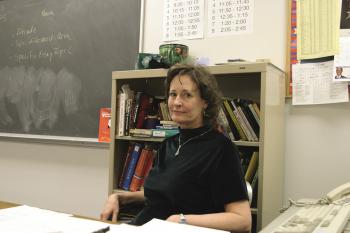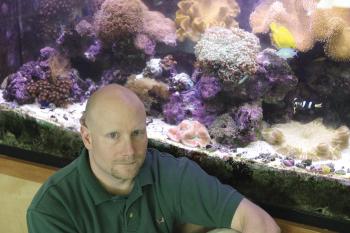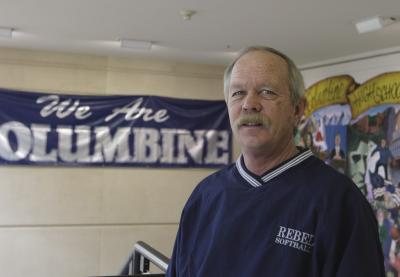This is a normal place of learning.
Students recite the Pledge of Allegiance in unison. Club announcements hang on walls. Choir classes prepare for concerts. Kids hold hands in hallways.

And this is not a normal place of learning.
This is a place of shadows, a place where the divide between "before" and "after" is as dramatic as the Rocky Mountain skyline. Teachers say evil entered here.
We all know what happened at Columbine. Five years later, news stories persist. Litigation and finger-pointing continue. Reporters corral students for off-campus comments. Groups ask permission to bless school halls. Buses park out front, and tourists brandish cameras at a distance.
Anything but normal.
Adages ring hollow here; time does not heal these wounds. The measured beats of a ticking clock do not erase what struck at the core of not only a school but a nation.
"We'll never be the same," Principal Frank DeAngelis said.
He and the 32 teachers who remain at the school since the time of the shootings — those who balance "before" and "after" most intimately — can attest to that.
They walk back into a reclaimed Columbine every day, and they carry with them an unspoken motto: Everyone is in a different place. A tacit code of silence looms — Do not speak of the tragedy — as each wrestles demons at different times, in individual fashion.
But change is slowly stirring. Teachers are beginning to speak of it, edging forward, seeking a toehold toward normalcy.
They are ending their silence.
That first year — the "after" so many have lived with — English teacher

would huddle in a fetal position behind his desk during planning periods. He could buoy students but not always himself.
Leyba stopped teaching Lord of the Flies and A Separate Peace, fiction too laden with real-life implications. He scanned the eyes of every student, paused at hallway intersections, always knew where an exit was.
Freshmen at the time of the shootings graduated in 2002.
"After we got the last kids out, I was able to look inward," he said. "I put bandages on for so long, now I've got to deal with it." New students, new seniors, have "given me the gift of normalcy," he explained.
He is ending his silence. Shadows remain, but he is more confident in teaching, even revisiting the once-abandoned literary works. His voice finds steady cadence now when speaking publicly about his experience.
Claudia Abbott returned to her English classroom in August 1999, four months after the shootings, to find it the way she had left it. Books were open to Raisin in the Sun. A stack of essays sat on her desk, never to be graded.
"I don't know how we did it," she said.
The tragedy shifted her teaching priorities. "What is important about what I teach can't be measured on a multiple choice test," she said, eyes defiant. "I want to help create compassionate human beings."

Of Mice and Men, another once-forsaken novel, is back in her classroom. "I didn't think I could teach those things again. But, it's not the material that's different; it's the way we handle it," she said. "Even in the dark side of things, there is a way to move it toward sympathetic understanding."
She is ending her silence. Counseling courses prepare her to help others in crisis, a new career she envisions when her teaching ends. She wonders about our current wars, how they divide a nation. She worries that Columbine's lessons already are forgotten.
Husband-and-wife science teachers Cheryl and Chris Mosier spent three hours separately sequestered in classrooms 25 feet apart during and after the shootings. Busy protecting their students, neither was certain of the other's fate.
Now, graduates — some of those students they helped shelter — return to the school to visit, asking a simple-sounding question: "How are you doing?" The answer is not so simple.
Cheryl keeps old astronomy assignments from that year "after," a time when lessons were less about science and more about coping, when students drew constellations accompanied with stories of grief. One student drew 13 stars representing the murder victims held safely in heaven.
Under his desktop glass, Chris keeps the student attendance roster of those with whom he spent slow minutes on April 20, 1999, until SWAT teams rescued them.
"To remind me of that day," he said.
Out of a science department of 12, they are two of the three who remain. A classroom poster of an isolated, blooming Columbine flower — struggling through a thin split of rock — mirrors their steadfast spirit.
They are ending their silence. Chris and Cheryl prepare to tell their story to new teachers, hoping to alleviate fears, breaking the code of silence.
There's more than "book learning" within these normal and not-normal school walls. Indeed, a pivotal lesson remains: Dedicated people can struggle through emotional upheaval, obtrusive media attention and unwanted fame to hold true to their mission of teaching children.
The school has a motto, shouted with honor: We are Columbine. It is a champion's call that captures the courage of this unique family, a call steeped in resurging spirit and reblooming hope. We are Columbine speaks of a simple yet hard-won truth: Out of tragedy, good can triumph.
